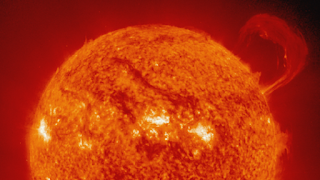A new study finds that the sun may reach the peak of its current activity cycle in 2024, one year earlier than official predictions.
But even after the Sun reaches its zenith, its wrath will continue to threaten the Earth for at least five years.
A team of scientists recently revealed improved and more accurate estimates of the strength and growth of the current solar cycle.
A 'plasma waterfall' that forms on the sun and can engulf eight planets
The team's final predictions for the current cycle expect it to peak in late 2024, one year earlier than NASA and the National Oceanic and Atmospheric Administration had predicted.
The team believes that the cycle of activity will reach about 185 monthly sunspots during its maximum, and therefore will be somewhat milder than the team originally expected.
The current cycle, the 25th since records began in 1755, began in 2019. According to official forecasts, it was supposed to be very mild, peaking with about 115 monthly sunspots in 2025.
The solar cycle lasts about 11 years, ebb and flow of the sun's magnetic activity, which is manifested in the number of sunspots, flares and solar eruptions.
These cycles vary in intensity, with the weakest producing less than a hundred spots per month during maximum and the strongest peaking at around 300 sunspots.
Cycle 25 was followed by a very weak Cycle 24, and NASA and the National Oceanic and Atmospheric Administration thought it would also be weak. However, since Cycle 25 gained strong activity in 2022, it has steadily outperformed the official forecast in line with an alternative forecast released by a team led by NASA research scientist Robert Lemon and Scott McIntosh, deputy director of the US National Center for Atmospheric Research (NCAR), who based Even though prediction of the solar cycle is still somewhat primitive, and with only 25 cycles recorded, the amount of data available for computer modeling is limited.
Physicists succeed in generating small solar flares in the laboratory!
Therefore, in their study, Lemon and McIntosh explore alternative methods for predicting the Sun's behavior based on the star's magnetic activity.
By analyzing historical records, they found that the strength of each subsequent cycle depended on when the previous cycle's magnetic field completely ended. This event, which the team has dubbed the terminator, does not happen at the minimum, but about two years later when the next solar cycle slowly wakes up.
"There is always an overlap between the old and the new," Lemon told Space.com. "If you measure the length of a cycle, not from minimum to minimum, but from interval to interval, you will see that there is a strong linear relationship between the length of one cycle and how strong the next cycle is." .
The original prediction made by Lemon and colleagues relied on anticipating the arrival of the Cycle-24 ending event in mid-2020, indicating a very strong Cycle-25.
However, cycle 24 ended up lingering for a year and a half, with its magnetic field finally disappearing completely in December 2021.
"When the glazing actually occurred, we changed the inputs and that gave us a somewhat more moderate prediction than we had originally expected," Lemon said.
The sunset events are part of what scientists call the Hale cycle, a 22-year cycle of magnetic activity that includes two 11-year solar cycles.
During the Hale cycle, magnetic waves of opposite polarity move from the sun's poles toward the equator, where they meet and cancel each other out. When these magnetic field lines are about halfway through their journey, the sun's magnetic field flips, which corresponds to the approximate time of the sun's maximum.
Revealing the Sun's fiery surface in a staggering combination of 90,000 images
The Hale cycle is complete when the magnetic field returns to its original state after two solar cycles. Ghassing, which is the cancellation of magnetic waves at the equator, can be observed in historical records of sunspot generation as the complete disappearance of sunspots in the equatorial region of a star.
Based on their calculations, Lemon and his colleagues expect the sun's magnetic field to flip in the middle of 2024, with the solar maximum for the current solar cycle reaching a few months later.
For us on Earth, that means we're likely heading into a period of more frequent and intense aurora displays, but also more intense space weather events that could create problems in Earth's orbit.
Aurora borealis are produced from interactions between material flowing from the Sun and the Earth's magnetic field. However, the similar reactions that produce this stunning natural light show the thickness of Earth's remaining atmosphere at high altitudes as satellites orbit.
This leads to increased drag that can cause satellites to fall out of orbit, among other problems. As an example, in February 2022, SpaceX lost a batch of 40 new Starlink satellites after launching in what forecasters deemed to be just a mild solar storm.
Lemon noted: “Because Cycle 25 is strange, we might expect the most impactful events to occur after reaching the maximum, in 2025 and 2026. This is because the poles of the sun turn every 11 years. The poles of the sun are in the same direction compared to the poles of the Earth so that it then causes a maximum damage."
Lemon added that the largest solar storms in the current cycle are likely to occur after maximum.
"We need to be vigilant for another five years," he said.
The team's latest predictions have been published in the journal Frontiers in Astronomy and Space Sciences.
Tags:
cambridge science
electrical sciences
genomic sciences
geo science
geosciences
life science
live science
neuroscience
science
science magazine
space science
strait of science






Excellent
ReplyDeleteGreat
ReplyDeleteGreat
ReplyDeleteGreat
ReplyDeleteGreat
ReplyDeleteSuper
ReplyDelete